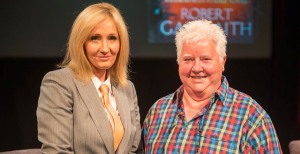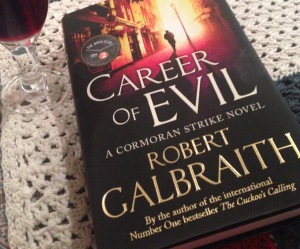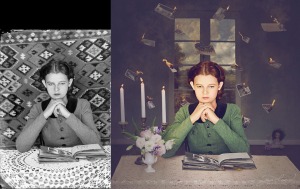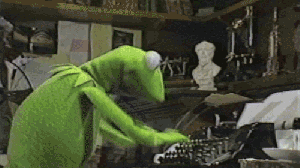He had not managed to scrub off all her blood. A dark line like a parenthesis lay under the middle fingernail of his left hand. He set to digging it out, although he quite liked seeing it there: a memento of the previous day’s pleasures.
As first paragraphs go, the latest Cormoran Strike novel has one of the best.
Atmospheric (not to mention some wicked tricolonic syntax) Robert Galbraith’s Career of Evil fires readers straight into the mind of a killer with all the propulsive force of a bullet.
Calling this character a killer, however, is something of an understatement. Galbraith (ok Rowling) has created a serial murderer with far more than a grudge against private investigator Cormoran Strike. And his sociopathic mind exists in a landscape more warped than many found in fact or fiction.
It’s darker as a novel. Less genteel but a lot more bizarre than either the Cuckoo’s Calling or The Silkworm. Dealing with paedophilia, serial murder and Body Integrity Identity Disorder (BIID) with equal amounts of candour and indulgence, the plot takes us across country and into the past, fills pages with macabre details and grisly redherrings.
Reading Career of Evil after attending its launch event, however, makes the departure from the previous two novels stark and strange.
Because the event I went to was almost the set for an Agatha Christie. It was positively Sherlockean, a puzzle game, intentionally similar to one of those tightly plotted, third-person omniscient mysteries.
Let’s put this into context.
Just a few photos. #MakeMeADetective @RGalbraith pic.twitter.com/iQtetxAjUf
— Harriet Allner (@TheScribbleBug) October 21, 2015
On Wednesday, Little, Brown hosted something like a dozen teams of mystery lovers (and Potterheads, lots of charming Potterheads), who they’d invited to become ‘a detective for the day’. With my crime writing finally on track, I of course leapt at the opportunity to feed my inner mystery solver.
It took place at London’s Time Run.
The first challenge was to find the place – which took me a good extra twenty minutes because I kept walking past it (not surprising given it’s not signposted and even the front door has buttons misdirecting you to people who don’t exist). Once inside, however, the 'Crystal Maze But Better' adventure space is all about immersive experience, and Little, Brown used it to recreate elements of The Silkworm. This meant that after a coffee and a short briefing, we were ushered to a door and into the reimagined halls of Roper Chard – the publishing house of Galbraith’s second novel. Distant sounds can be heard upon entering, tinned laughter and clinking glasses. We’re at the drinks party attended by Cormoran Strike (who infiltrates it during the novel to discover more about the publishing house and its authors). However, in this version, Owen Quinn is still missing and it’s up to us – a motley team of five – to find a manuscript that might uncover his whereabouts, hopefully alive.
The odd mix of Victoriana, curiousity shop and publishing house made for an exciting trip into Galbraith’s fictional world, and as we solved one clue after another, racing against the clock, we were filled with a childish, gleeful excitement.
Team 5 challenge complete! #MakeMeADetective@RGalbraith Had so much fun, can we do it ag… https://t.co/v1xsevzdtNpic.twitter.com/ZMmNzYookZ
— Jax Blunt (@liveotherwise) October 21, 2015
We did pretty well. For about an hour we were even in the running for the signed and dedicated copies of the book by Robert Galbraith "himself".
The success was totally a team effort. We were brilliant together – each of us with a different way of thinking and problem solving. We had the eminently logical and the creatively minded. The type who know every twist and trope in crime fiction and therefore know exactly where we need to be looking, and then the kind who understand puzzles and games and how to solve them. Together we worked well and it was great to play the detective with them. (Read More from Jax, who was on the same team here)
Yet this quintessential crime narrative, the Sherlock style solving of clues, the ‘shut-room’ mystery, is a farcry from the topsy-turvy morbidity of Career of Evil. In fact, the only real similarity is the ever-building chemistry between Robin and Strike, and the exuberance of the writing.
 |
| Cormoran Strike & Robin Ellacott |
Plus, though this may be because I’ve read an awful lot of Ian Rankin and McIllvanney the Elder and Younger, compared to either The Cuckoo’s Calling or The Silkworm, this novel is decidedly more akin to those of the Tartan Noir clan.
Whilst set in London much more time is spent bombing around the United Kingdom, including a jaunt around Scotland in a Mini. Galbraith also spends longer constructing personalities - beyond the sensationalistic elements, the shifts of the narrative voice into that of the serial killer himself attempt to capture something of that coy, insightful type of profiling familiar to any reader of Val McDermid. Then there's the sort of 'Tony Hill / Carol Jordan', 'Will Trent / Sarah Linton' sexual tension thing that we're all so used to seeing in today's crime fiction.

Admittedly, there's something of the romantic comedy in this pair compared to McDermid's most famous partners. Here are two protagonists who clearly fancy each other much more than they do their respective S/Os but have yet to figure this out despite all their super-sleuthing powers.
Different is not necessarily better, but neither is it worse. It's just different. I'd be quite nervous to be thrown into the Time Run 'experience' of Career of Evil.
Overall, Galbraith's latest novel is a compelling read. It has it's 'daft' points, as the Guardian said, though I think those parts are what stop it from being overwrought and heavy. It also has it's faintly unpleasant moments (the toe, guys, the toe) but they're not gratuitous - we're not talking gore and grit and horror here.
So with this in mind, I would recommend Career of Evil to any crime fan, but if you're looking for the goofy and sly satirical plot of the previous two novels, that's not what you'll find here.
This is Galbraith at "his" most fiendish and entertaining.
If that entertainment is a little gruesome along the way, so be it.
Je serai poète et toi poésie,
SCRIBBLER
Buy Career of Evil, the third book in the highly acclaimed crime fiction series by J.K. Rowling, writing under the pseudonym Robert Galbraith, at your nearest bookstore - Hardback £20, ebook £10.99 - or check out Wordery.com to order online.




